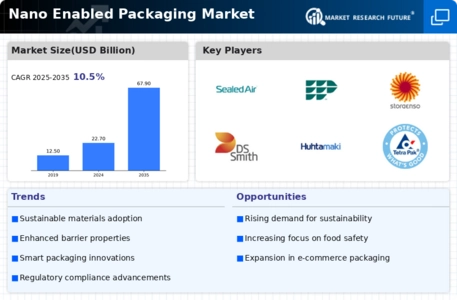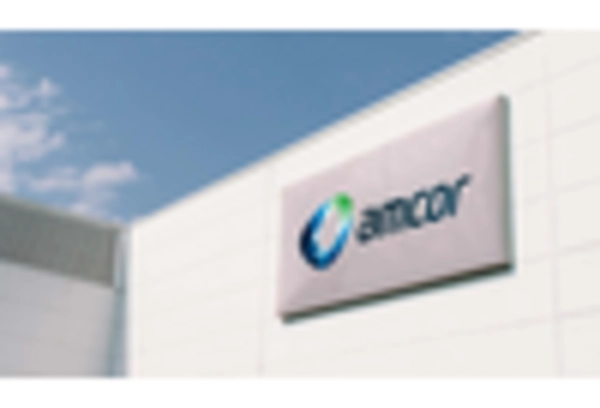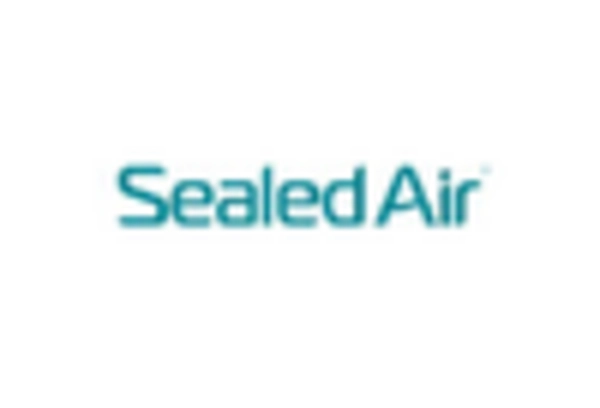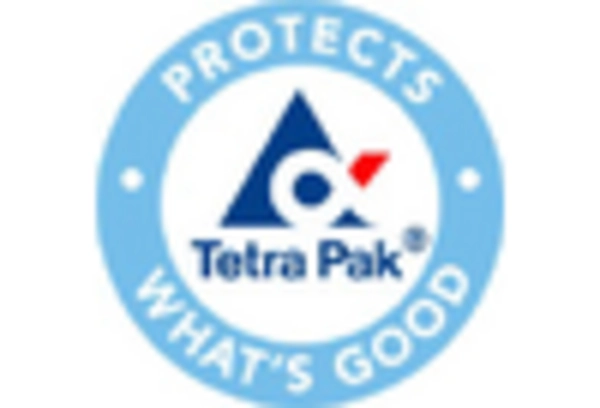Technological Innovations
Technological advancements in nanotechnology are significantly influencing the Nano Enabled Packaging Market. Innovations such as nanocomposites and nanocoatings are enhancing the performance of packaging materials, offering improved barrier properties, strength, and flexibility. For instance, the incorporation of nanoparticles can lead to lighter packaging solutions that maintain structural integrity while reducing material usage. The market for nanotechnology in packaging is expected to grow at a compound annual growth rate of around 20% over the next few years, driven by these technological breakthroughs. Furthermore, the ability to incorporate smart features, such as sensors and indicators, into packaging through nanotechnology is likely to enhance consumer engagement and product safety. This technological evolution is thus a key driver for the Nano Enabled Packaging Market.
Sustainability Initiatives
The increasing emphasis on sustainability within the packaging sector appears to be a pivotal driver for the Nano Enabled Packaging Market. As consumers become more environmentally conscious, companies are compelled to adopt eco-friendly practices. This shift is reflected in the growing demand for biodegradable and recyclable materials, which nano-enabled packaging can provide. The market for sustainable packaging is projected to reach approximately 500 billion USD by 2027, indicating a robust growth trajectory. Nano-enabled solutions not only enhance the shelf life of products but also reduce waste, aligning with the sustainability goals of various industries. Consequently, the integration of nanotechnology in packaging is likely to play a crucial role in meeting these environmental standards, thereby propelling the Nano Enabled Packaging Market forward.
Global Supply Chain Optimization
The optimization of supply chains through nanotechnology is emerging as a crucial driver for the Nano Enabled Packaging Market. As companies strive to enhance efficiency and reduce costs, the application of nanomaterials in packaging can lead to significant improvements in logistics and distribution. For example, lighter packaging materials can reduce transportation costs and carbon footprints, aligning with corporate sustainability goals. Additionally, the use of nanotechnology can enhance the durability of packaging, minimizing damage during transit. Market analysis suggests that the adoption of nano-enabled solutions could lead to a reduction in supply chain costs by up to 15%. This potential for cost savings and efficiency improvements is likely to drive further investment in the Nano Enabled Packaging Market.
Regulatory Support and Standards
Regulatory frameworks and standards supporting the use of nanotechnology in packaging are emerging as a significant driver for the Nano Enabled Packaging Market. Governments and regulatory bodies are increasingly recognizing the potential benefits of nanotechnology, leading to the establishment of guidelines that facilitate its safe application in packaging. For instance, regulations that promote the use of safe nanomaterials can enhance consumer confidence and encourage manufacturers to adopt these technologies. The establishment of clear standards is expected to foster innovation and investment in the sector, potentially leading to a market expansion valued at over 30 billion USD by 2026. This supportive regulatory environment is likely to be instrumental in shaping the future of the Nano Enabled Packaging Market.
Consumer Demand for Enhanced Features
The rising consumer demand for enhanced packaging features is a notable driver for the Nano Enabled Packaging Market. Modern consumers increasingly seek packaging that not only protects products but also offers additional functionalities, such as freshness indicators and tamper-proof seals. The integration of nanotechnology allows for the development of packaging that can actively respond to environmental changes, thereby ensuring product integrity. Industry expert's indicates that approximately 60% of consumers are willing to pay a premium for packaging that offers these advanced features. This trend suggests that companies investing in nano-enabled solutions may gain a competitive edge in the marketplace. As a result, the demand for innovative packaging solutions is likely to continue driving growth within the Nano Enabled Packaging Market.


















Leave a Comment